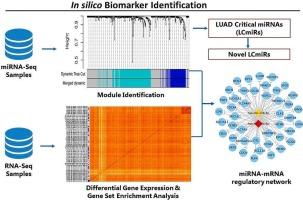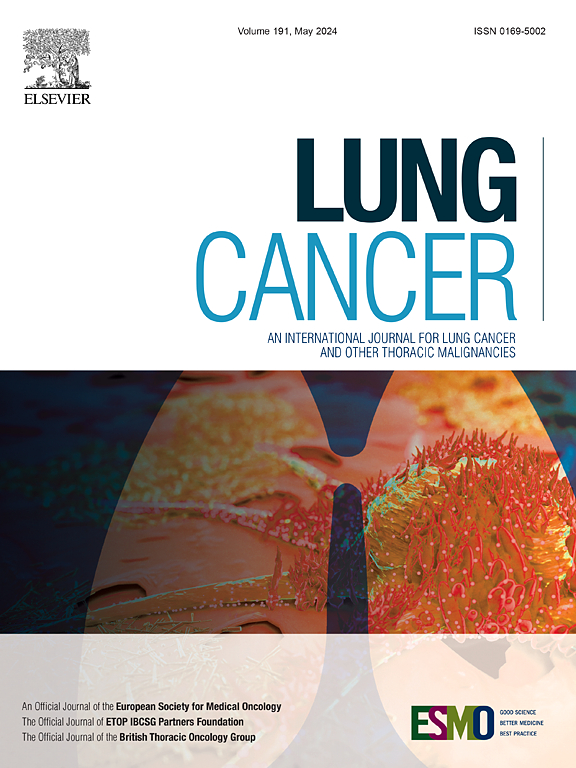Transcriptome analysis reveals crucial oncogenic and tumor suppressor miRNAs in lung adenocarcinoma
IF 4.4
2区 医学
Q1 ONCOLOGY
引用次数: 0
Abstract
Background
MicroRNAs (miRNAs) play essential roles in post-transcriptional gene regulation and are increasingly recognized as key regulators in various diseases. This study aimed to identify the key miRNA biomarkers and decodes their regulatory mechanism involved in human lung adenocarcinoma (LUAD) using network-based integrative multi-omics approaches.
Methods
We applied Weighted Gene Co-expression Network Analysis (WGCNA) method on miRNA-Seq data to detect key miRNA modules that correlated with the disease traits. Then we used differential expression profile, level of gene significance, module-trait relationship, target-identification, gene set enrichment analysis (GSEA), and survival analysis approaches to decipher LUAD critical miRNAs.
Results
Our analysis demonstrated a core set of LUAD critical miRNAs (called as LCmiRs) that comprises 33 oncogenic and 17 tumor suppressor miRNAs. These key miRNAs were then mapped to their target mRNAs through a target-identification approach, allowing for the construction of miRNA-mRNA interaction networks that revealed critical regulatory relationships. The GSEA results showed that upregulated mRNAs, those were targets of downregulated miRNAs (i.e., tumor suppressor miRNAs), were predominantly associated with pathways related to cell division, oocyte maturation/meiosis, TGF-beta signalling pathway, and metabolic processes, while downregulated mRNAs, those were targets of upregulated miRNAs (i.e., oncogenic miRNAs), were linked to angiogenesis, negative regulation of growth, and receptor-mediated signaling. Validation of the identified oncogenic/tumor-suppressor miRNAs reported five novel miRNAs. Among these, the oncogenic miRNAs are hsa-miR-18a-3p, hsa-miR-589-3p, hsa-miR-1229-3p, and hsa-miR-3651, and tumor suppressor one is hsa-miR-618.
Conclusions
This study provides a systematic in silico framework for identifying LUAD associated miRNAs. The discovery of five novel miRNAs highlights their potential as diagnostic biomarkers and therapeutic targets, offering valuable insights for experimental and clinical investigations in LUAD.

转录组分析揭示了肺腺癌中至关重要的致癌和抑瘤mirna
micrornas (miRNAs)在转录后基因调控中发挥着重要作用,并日益被认为是多种疾病的关键调控因子。本研究旨在利用基于网络的综合多组学方法,鉴定关键miRNA生物标志物,并解码其与人肺腺癌(LUAD)相关的调控机制。方法应用加权基因共表达网络分析(Weighted Gene Co-expression Network Analysis, WGCNA)方法对miRNA- seq数据进行分析,检测与疾病性状相关的关键miRNA模块。然后,我们使用差异表达谱、基因显著性水平、模块-性状关系、目标鉴定、基因集富集分析(GSEA)和生存分析方法来破译LUAD关键mirna。结果:我们的分析显示了一组核心的LUAD关键mirna(称为LCmiRs),其中包括33个致癌mirna和17个肿瘤抑制mirna。然后通过目标识别方法将这些关键mirna映射到它们的目标mrna,从而允许构建miRNA-mRNA相互作用网络,揭示关键的调控关系。GSEA结果显示,下调miRNAs(即肿瘤抑制miRNAs)的靶标上调的mrna主要与细胞分裂、卵母细胞成熟/减数分裂、tgf - β信号通路和代谢过程相关,而上调miRNAs(即致癌miRNAs)的靶标下调的mrna则与血管生成、生长负调控和受体介导的信号传导相关。鉴定的致癌/肿瘤抑制mirna的验证报告了五个新的mirna。其中,致癌mirna为hsa-miR-18a-3p、hsa-miR-589-3p、hsa-miR-1229-3p、hsa-miR-3651,抑瘤mirna为hsa-miR-618。结论本研究为LUAD相关mirna的鉴定提供了一个系统的芯片框架。这五种新型mirna的发现凸显了它们作为诊断生物标志物和治疗靶点的潜力,为LUAD的实验和临床研究提供了有价值的见解。
本文章由计算机程序翻译,如有差异,请以英文原文为准。
求助全文
约1分钟内获得全文
求助全文
来源期刊

Lung Cancer
医学-呼吸系统
CiteScore
9.40
自引率
3.80%
发文量
407
审稿时长
25 days
期刊介绍:
Lung Cancer is an international publication covering the clinical, translational and basic science of malignancies of the lung and chest region.Original research articles, early reports, review articles, editorials and correspondence covering the prevention, epidemiology and etiology, basic biology, pathology, clinical assessment, surgery, chemotherapy, radiotherapy, combined treatment modalities, other treatment modalities and outcomes of lung cancer are welcome.
 求助内容:
求助内容: 应助结果提醒方式:
应助结果提醒方式:


